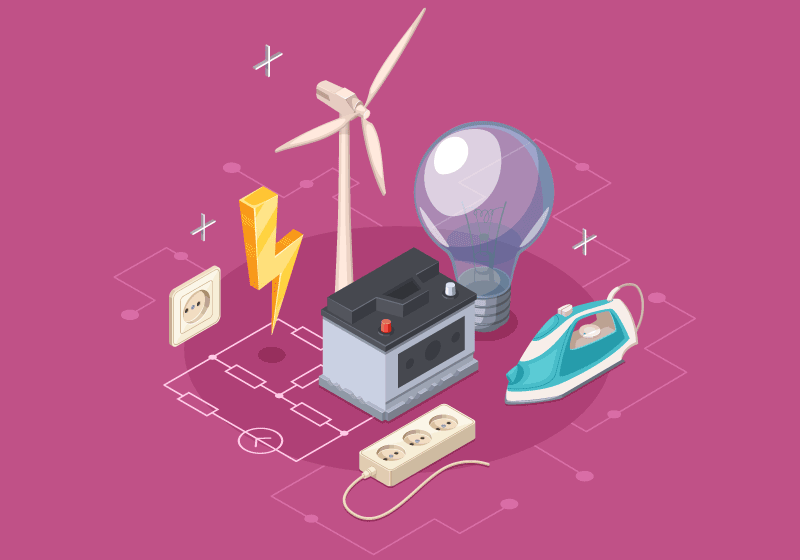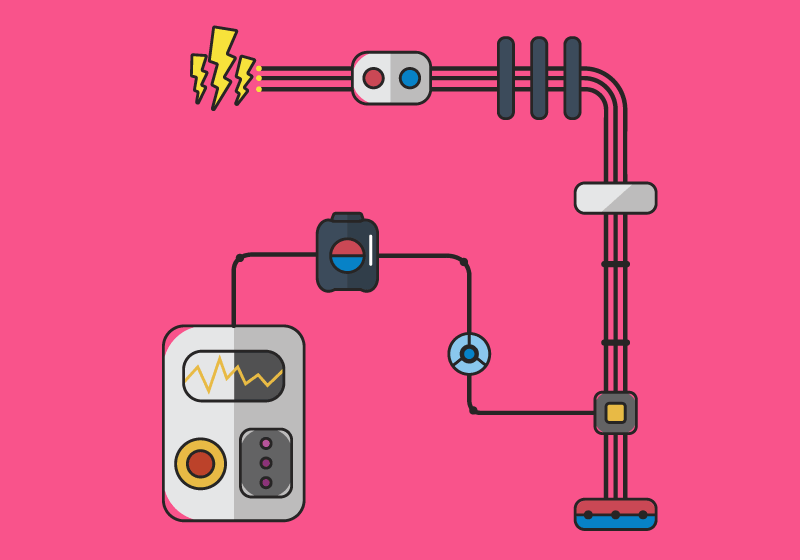Wave Speed
Wave speed is given in meters per second (the number of waves that pass per second). Wavelength is measured in meters and frequency is measured in hertz (Hz), or number of waves per second. Demo In this tutorial you will learn how to calculate the speed of a wave. The equation for this calculation is written like this: $v = { \text f \; \text x \; \lambda }$ Chilled practice question Calculate the velocity of a wave with a wavelength of 6 m and a frequency of 50 Hz Frozen practice question Find the velocity of a wave which has a time…
Force on a Spring
When a force acts on a spring it is stretched or compressed, its length will changes by an amount e from its original length. Demo In this tutorial you will learn how to calculate the force on a spring given its extension and spring constant. Note-Some mobile devices may require you to tap full screen during playback to view video content. The equation for this calculation is written like this: $F = { \text k \; \text x \; \text e}$ Chilled practice question Copy out the question and attempt to calculate the answer before watching the solution. Write down the equation…
Force, Mass and Acceleration
An object of constant mass accelerates in proportion to the force applied. Demo In this tutorial you will learn how to calculate the force applied to an object if you are given its mass and acceleration. The equation for this calculation is written like this: $F = { \text m\; \text x \; \text a}$ Chilled practice question Calculate the force applied to cannon ball which accelerates at 7m/s2 which has a mass of 5 Kg. Frozen practice question A rocket has a driving force of 15 N and a mass of 250 g. Calculate the acceleration of the rocket. Science in context Force (N)…
Kinetic Energy
In physics, the kinetic energy (KE) of an object is the energy that it has due to its motion. It is defined as the work needed for an object of a known mass to accelerate to a given velocity. What is Kinetic energy? In physics, the kinetic energy (KE) of an object is the energy that it has due to its motion. It is defined as the work needed for an object of a known mass to accelerate to a given velocity. Kinetic energy equation To calculate Kinetic energy we write the equation like this. $E_k = { 1 \over2} mv {^2}$ Kinetic energy demo In this tutorial you will learn how…
Specific Heat Capacity
Specific heat capacity is how much heat energy is required to raise 1 kg of a substance by 1 °C. What is Specific heat capacity? Specific heat capacity is how much heat energy is required to raise 1 kg of a substance by 1 °C. Specific heat capacity is the amount of heat energy required to raise the temperature of a substance per unit of mass. The specific heat capacity of a material is a physical property and different materials have a different specific heat capacities. Specific heat capacity equation To calculate Specific heat capacity we write the equation like…
Power
The quantity power is the rate at which work is done. The quicker work is done the greater the power. What is Power? The quantity power is the rate at which work is done. The quicker work is done the greater the power. The standard metric unit of power is the Watt. The calculation of power is the work done in Joules divided by a unit of time seconds. 1 Watt is equivalent to 1 joule of work done per second. Many machines have their power rating displayed upon them in Watts, the higher the value the greater the power…
Elastic Potential Energy
Stretching or squashing an object can transfer energy into its elastic potential energy store. What is Elastic potential energy? Stretching or squashing an object can transfer energy into its elastic potential energy store. Elastic energy is the mechanical potential energy stored in the material. Elastic energy occurs when objects are compressed, stretched or deformed. Elastic potential energy equation To calculate Elastic potential energy we use this equation. $E_e = { 1 \over2} ke {^2}$ Elastic potential energy demo In this tutorial you will learn how to calculate the energy stored in a stretched spring. Chilled practice question A spring is…
Charge
The size of the current is the rate of flow of charge. Electrons are negatively charged particles which transfer energy through wires as electricity. What is Charge? The size of the current is the rate of flow of charge. Electrons are negatively charged particles which transfer energy through wires as electricity. Charge is measured in coulombs (C). Electrons are really small and the effect of one electron would be really difficult to measure, It is easier to measure the effect of a large number of electrons. One Coulomb of charge contains 6 × 1018 electrons. Charge equation To calculate Charge we use this…
Resistance
Resistance is an electrical quantity that measures how a device or material reduces the electrical current flow through it. What is Resistance? Resistance is an electrical quantity that measures how the device or material reduces the electrical current flow through it. Resistance is measured in ohms (Ω).If we make a comparison of resistance to water flow in pipes, the resistance is greater when the pipe is thinner, so the water flow is decreased It slows down which also happens to the flow of electricity. Resistance equation To calculate Resistance we write the equation like this. $V = { \mathit I…
Electrical Power
The power of an appliance is the energy that is transferred per second. Electric power is the rate, per unit time at which electrical energy is transferred by an electric circuit. What is Electrical power? The power of an appliance is the energy that is transferred per second. Electric power is the rate, per unit time, at which electrical energy is transferred by an electric circuit. The unit for power is the watt, which is the transfer of energy at the rate of one joule per second. Electric power can be produced by electric generators and batteries. Electrical power equation…
Density
Density is a measure of how compact the particles are in a substance. Density is defined as the mass per unit volume. What is Density Density is a measure of how compact the particles are in a substance. Density is defined as the mass per unit volume. It is mathematically defined as mass divided by volume: ρ = m/V. The density(ρ) of a substance is the total mass (m) of that substance divided by the total volume (V) Of the substance. Density equation To calculate Density we use this equation. ${\rho} = {\text{m} \over\text{V}}$ Density demo In this tutorial you will learn how…
Specific Latent Heat
Specific latent heat is the energy needed to change the state of a substance. What is Specific latent heat? Specific latent heat is the energy needed to change the state of a substance. Latent heat is the energy absorbed or released by a substance during a change in its physical state. The latent heat is normally shown as the amount of heat energy in joules per Kg mass of the substance undergoing the change of state. Specific latent heat equation To calculate Specific latent heat we use this equation. $E = {\text{m} \text{L}}$ Specific latent heat demo In this tutorial you will learn how…
Gravitational Potential Energy
Lifting an object in a gravitational field transfers energy into the objects gravitational energy store. Gravitational potential energy is the energy an object has due to its height above Earth. What is Gravitational potential energy? Lifting an object in a gravitational field transfers energy into the objects gravitational energy store. Gravitational potential energy is the energy an object has due to its height above Earth. The equation for gravitational potential energy is GPE = mgh, where m is the mass in kilograms, g is the gravitational field strength (9.8 N/Kg on Earth), and h is the height above the ground in meters. Gravitational potential energy equation To calculate Gravitational potential…
Energy Transformed
The potential difference between two points is the energy transferred per unit charge. An electrical circuit is an energy transformation device. What is Energy transformed? The potential difference between two points is the energy transferred per unit charge. An electrical circuit is an energy transformation device. Energy is provided to the circuit by an electrochemical cell, battery, generator or another electrical energy source. Energy is delivered by the circuit. The rate at which this energy transformation takes place has a great relevance to the design of an electrical circuit for useful functions. Energy transformed equation To calculate Energy transformed we…
Forces and Work Done
The unit for work done is the joule (J), or Newton meter (N-m). One joule is equal to the amount of work that is done when 1 N of force moves an object over a distance of 1 m. Demo In this tutorial you will learn how to calculate the work done to move an object through a known distance. Note-Some mobile devices may require you to tap full screen during playback to view video content. The formula for this equation is written like this: w = f x d Chilled practice question Copy out the question and attempt to calculate the answer before watching the solution. Write down the…
Momentum
All moving objects have momentum. Forces can cause changes in momentum. The total momentum in a collision or explosion is conserved and stays the same. Car safety features absorb energy involved in a crash they slow down the collision thus reducing the force of impact. Demo In this tutorial you will learn how to calculate the momentum in a moving object. The equation is written like this: $P = { \text m\; \text x \; \text v}$ Chilled practice question Calculate the momentum of a 1200 Kg vehicle travelling at 5 m/s. Frozen practice question A girl has a mass…
The Motor Effect
A current-carrying wire or coil can exert a force on a permanent magnet. The force increases if the strength of the magnetic field and/or current increases. This is called the motor effect. Demo In this tutorial you will learn how to calculate the force on a wire carrying a current in a magnetic field. The equation is written like this: $F = { \text B \; \text x \; \text I \; \text x \; \text L}$ Chilled practice question Calculate the force on a wire carrying a current of 3 A. 0.25 m of the wire is in the magnetic field. The magnetic flux density…
Uniform Acceleration
Uniform or constant acceleration is a type of motion in which the velocity of an object changes by an equal amount in every equal time period. Demo In this tutorial you will learn how to calculate uniform acceleration. The equation is written like this: ${ \text v^{2} \; \text – \; \text u^{2} \; \text = \; \text 2as}$ Chilled practice question A racing car travelling at 20 m/s decelerates uniformly at 1.5 m/s2 towards a slip road 100 m away. Calculate its velocity when it reaches the slip road. Frozen practice question A ball is dropped 12 m from the top of…
Acceleration
Acceleration is how quickly the velocity is changing whether it be speed, direction or both. Acceleration is a measure of how quickly the velocity of an object is changing. Demo In this tutorial you will learn how to calculate the acceleration of a moving object. The equation is written like this: $a = { v \unicode{x2013} u \over \text{t}}$ Chilled practice question Calculate the acceleration if the velocity increases from 4 m/s to 76 m/s in 8 s. Frozen practice question How long does it take for the velocity of a bus to increase from 12 m/s to 20 m/s…
Speed
Speed is how fast an object is moving in no given direction. Velocity is how fast an object is moving in a given direction. In physics, you can calculate the average speed by taking the total distance travelled and dividing it by the total time required to travel that distance. Demo In this tutorial you will learn how to calculate the speed of an object, velocity is speed with direction for example 20 m/s north. The equation is written like this: $S = { \text D / T}$ Chilled practice question Calculate the speed of a car which travels 2000 m in 400 s. Frozen…
Weight on the Moon
Weight is the force acting on an object due to gravity. The weight of an object is defined as the force of gravity on the object and can be calculated as the mass times the acceleration due to gravity. Demo In this tutorial you will learn how to calculate the weight of an object on the moon due to its force of gravity. The equation is written like this: ${ \textit W} = {\text m \;} {\text x \;} {\text g}$ Chilled practice question Copy out the question and attempt to calculate the answer before watching the solution. Write down the equation…
Weight on Earth
Weight is the force acting on an object due to gravity. The weight of an object can be defined as the force of gravity on the object. Since the weight is a force, its unit is the Newton. Demo In this tutorial you will learn how to calculate the weight of an object due to the force of the Earths gravity. The equation is written like this: ${ \textit W} = {\text m \;} {\text x \;} {\text g}$ Chilled practice question Calculate the weight of a bench on Earth which has a mass of 25 Kg. Frozen practice question Calculate the mass of…




















